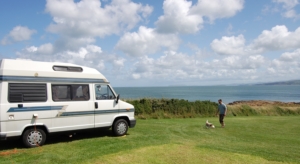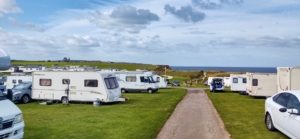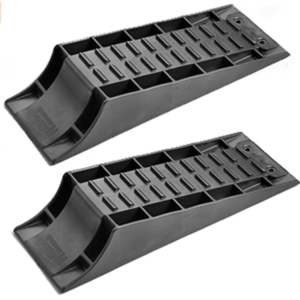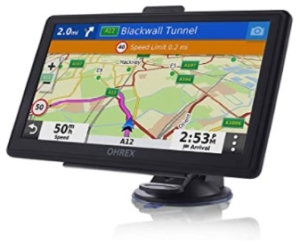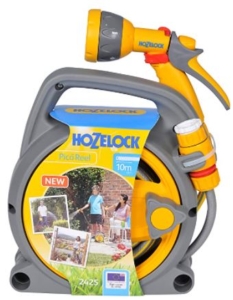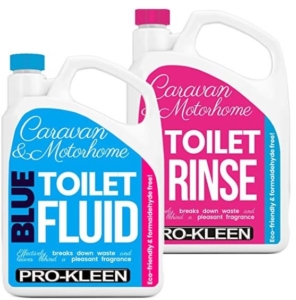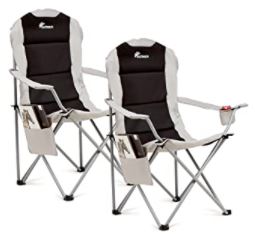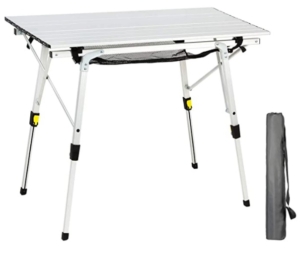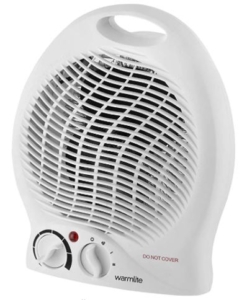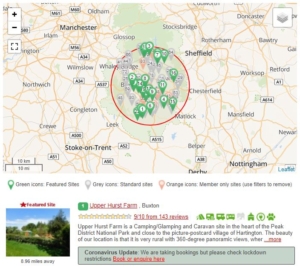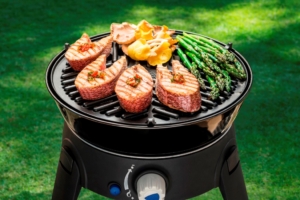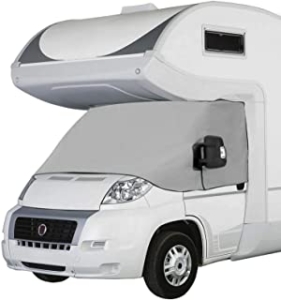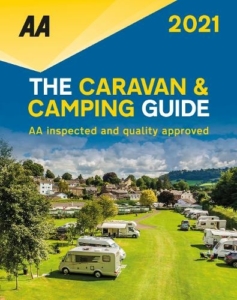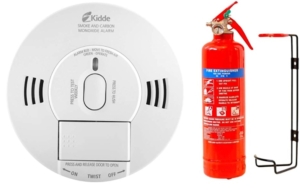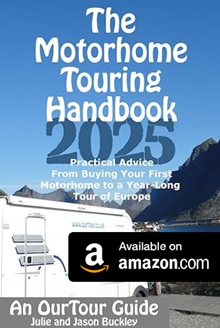Essential Motorhome Kit for a UK Road Trip
Here’s the essential equipment we pack for a motorhome or campervan holiday in the UK. With this kit you’ll be kept safe, able to find great places to stay, plus keep all the essentials running: power, water, heating, the toilet and, of course, a delicious outdoor BBQ!
Please note: We’ve linked to great-quality products on Amazon which we either use ourselves or know others rate highly. We always make it clear if we’ve been given kit in return for a review (which happens rarely, we normally buy our equipment like everyone else). If you click on any of these links and buy from Amazon, you’ll pay the exact same price but they’ll give us a small percentage of their profit.
Electrical Hook-Up Cable
We carry a single 25 metre long electrical hook-up cable, which allows us to connect to the mains electricity provided on campsites. In turn this charges our leisure batteries and lets us run 230V appliances in the van.
Hints and Tips
- A second cable can be useful if having hook-up is important to you (if you don’t have a solar panel for example), as electricity points can be some distance from pitches.
- If you have a cable on a reel, be aware it might heat up if you run a high load like a heater for any length of time, think about unravelling the entire reel.
- Create a ‘leaving site’ checklist which includes disconnecting your cable, so you don’t try and drive off still hooked-up (it happens).
- If you’re thinking of heading abroad in future, get one of these two pin adapters with you as many sites on the continent still use them (some sites in Switzerland even use a three-pin socket, like this).
This cable comes with a carry bag (useful to keep you lockers clean when it’s muddy) and a 3 pin plug (handy for plugging your van in at home or into a powerpack like the one later in this list, to keep your leisure batteries charged).
Levelling Ramps
Lots of campsite pitches aren’t quite level. While a slight slope’s not much of an issue, it’s more comfortable in our motorhome when we don’t feel like we’re rolling out of bed or climbing uphill to the kitchen. 3-way fridges work better when they’re level too. By driving two front, side or rear wheels onto these ramps you can get your van level.
Hints and Tips
- A small spirit level like this placed on a flat surface inside your van can help you get level.
- It’s hard to drive up ramps when you’re on a slope, it’s easier to slowly reverse onto them. Having someone outside using visual hand signals to show how high up the ramps the van is can also really help the driver.
- Check your ramps won’t hit anything on your van. We damaged our bumper when ours ‘bounced up’ as we reversed too quickly off them on a grassy surface.
We’ve a fairly large (3.5 tonne, 6m long) motorhome and park up all over the place, so have to cope with some steepish slopes at times. We carry large heavy duty Milenco levelling ramps to enable us to still get level. These are heavy and take up a fair bit of locker space though, so we’ve linked to some smaller best-selling ones on Amazon below.
Satellite Navigation (SatNav GPS)
For many of us our motorhome will be the largest, heaviest, widest and tallest vehicle we drive. Having either a motorhome-specific Sat Nav or a travelling partner scanning the map for low bridges, narrow roads and steep hills is very handy for keeping stress levels nice and low!
Hints and Tips
- We find using GPS co-ordinates easier than searching for addresses. Most websites and apps give the co-ordinates of campsites these days.
- Despite the cracking technology in these devices, we still find cross-referencing against a paper map builds our confidence we’re not trying to use roads which are too small or might be flooded or snowbound. We use a spiral-bound AA Britain Road Atlas.
- If you think you might extend your tours abroad, get a sat nav with full European maps and updates included.
There are a ton of motorhome sat navs available and we’re no experts in them, but we’re currently trialling the low-cost OHREX Truck 7″ one we’ve linked to here and are very happy with it so far.
Hosepipe
You’ll need to be able to refill your fresh water when on site for washing in your van’s sinks and shower. Not every campsite will have a hosepipe for you to use so people tend to carry their own. Most taps have a 1/2 inch screw end so you can attach a Hoselock-style connector like the one included with this hosepipe.
Hints and Tips
- Expandable pipes take up little space in your locker but we’ve found they’re harder to keep clean and dry than a ‘standard’ hosepipe.
- We have about 10m of pipe and find that’s long enough almost everywhere.
- In some situations we can’t attach a hosepipe to the tap (it’s too far way, we don’t want to move the van or it has no screw thread and is shaped like a duck bill – this happens!), in which case we carry a collapsable water carrier like this one.
- If you plan to drink water direct from your on-board tank, we recommend cleaning the tank first using a steriliser like this highly-reviewed one to ensure there are no nasties in there.
Toilet Chemicals
Trust us, you’ll be wanting something to keep your motorhome toilet or porta-potti clean and smelling fresh. That’s where these liquids (which everyone refers to as ‘chemicals’ ) come in. The blue one goes into the toilet cassette after you’ve emptied it, and the pink one’s used to keep the bowl clean.
Hints and Tips
- Some motorhome toilets have a ‘flush’, which rinses water around the bowl, it doesn’t wash away your poop like a house toilet. These don’t always create a stong flow of water, so we carry a small spray bottle like this, and pop some watered-down pink chemical fluid in there to give the bowl a quick blast after each use.
- You can buy expensive specialist loo roll like this for your motorhome toilet, but we find cheap 2 ply supermarket paper breaks down just as well.
- Don’t expect miracles from these chemicals. The best way to keep the smell away is to empty and clean the cassette each day or two, or fit a SOG ventilation system like this one (make sure you get the right kit for your model of cassette).
Camping Chairs
Part of the great attraction of motorhome holidays is that sense of being closer to the world around you. Being sat outside in the (hopefully) sun with a beer kept nice and cold in your fridge can’t be beat. Or maybe you’re relaxing with a glass of wine, chatting with neighbours after a day’s walking, life’s good!
Hints and Tips
- Think about storage when you’re buying your chairs: will they easily fit in your lockers? We have two collapsable chairs like the ones shown here, plus a ‘lounger’ chair which we have to carry on our bike rack as it’s too large to fit in a locker, and it would drive us crazy rattling around inside the van.
- We’ve used cheap chairs before and regretted it when they broke after not much use. It’s worth spending a little more on better quality and more comfortable chairs.
- The drinks holders some chairs have on their arms come in very handy, not just for your chosen beverage, but for bits and bobs of rubbish like corks, snack wrappers and bottle tops.
- Carry bags come in handy once in a while, but we hardly ever use ours.
Camping Table
Camping tables extend your eating and entertaining space outdoors, and the best ones are light, quick to put up and take down and take up very little space when they’re stored.
Hints and Tips
- Think about spending a little more to get a better quality table as they last for ages. We’ve used ours for holidays and long-term tours for over ten years now, just needing to replace some elastic when it eventually went a bit limp.
- We currently have a table like this, but the button below takes you to the one we’d buy now (pictured opposite) if we had to replace it. Why? It looks very well made, easy to clean and store, faster to assemble and collapse, more stable, and has adjustable legs for surfaces which aren’t flat.
Electrical Fan Heater
While we all love our native isles, they’re not always the warmest places in the world! Even the best of winterised motorhomes can be a little cool in the evenings and early mornings.
Our motorhome has a blown-air, gas-powered heating system, but we still carry a small electrical fan heater like this one. Why? Because when we’re hooked-up to campsite electricity it enables us to keep the chill off while avoiding eating into our gas stash.
Hints and Tips
- These heaters have a thermostat so you can leave them running while you’re not in the van or asleep.
- Be careful if you have a theft alarm though, our heater sets the van’s alarm off when it kicks in, which we only discovered when we once went out for the day and left it on (we were very unpopular when we came back…).
- Fan heaters make some noise. If this bothers you think about a halogen one like this.
- In deep cold (freezing temperatures) we also run our blown-air gas-powered heating, as the ducts run through the cupboards and past our water tanks, preventing condensation and freezing.
Portable Power Pack
It can be much easier and cheaper to grab a pitch which doesn’t have electrical hook-up. With a leisure battery in your van you’ll be able to run your lights, 12V TV and heating fan without mains power, but eventually (without a solar panel) the battery will go flat. If you’ve a lead-acid battery (which most of us do) it won’t like this, they get damaged if they’re discharged too often below 50%, and will no longer hold charge.
One way to avoid this is to carry a rechargeable power pack and use it to charge all your gadgets, power lights and so on. If you get one with an inverter built-in, then you’ll be able to run small 230V kit too (but not hair dryers and microwaves, you’ll need the mains for that).
This FLYLINKTECH power pack is small and lightweight, but has a large 75Ah capacity and can be safely fully discharged, thanks to its Lithium Iron battery. It has an inverter and gets great reviews on Amazon.
Campsite Apps and Websites
How do you find the perfect sites for you? Near to a pub maybe, or with a sea view, which has pitches for touring motorhomes, has electrical hook-up and accepts dogs? This is where websites and smartphone/tablet apps really come into their own.
Paper books still have their place (see below) but these days we rely heavily on websites like those listed here. Some of these have associated apps too, which access the same information but are a bit slicker to use on smaller screens. If you’ve a smartphone with an internet connection most places across the UK have a 3G or 4G signal now, so you’ll be able to access these databases while you’re on the road.
Some of the Best UK Campsite Websites
We like ukcampsite.co.uk the best, as it has such a great range of filters to help us pick sites which suit our needs the best.
Gas BBQ
The charcoal BBQ’s a little out of favour these days, its demise perhaps ushered in that bit more quickly by the iconic Safari Chef gas BBQ, which everyone seems to have these days.
There’s a range of Safari Chef models, but they all pack down into a relatively small heavy-duty bag, are easy to clean, don’t require you to carry a dirty bag of charcoal and campsite owners tend to prefer us using them as they don’t damage the ground and have a lower fire risk than charcoal in dry spells.
Hints and Tips
- Campingaz have a competing gas BBQ range which is also worth a look.
- You can either carry a separate gas bottle for the BBQ or, if you use the BBQ a lot, get an external gas BBQ point fitted to your van.
- Save money on gas by getting a Safefill bottle, which you can safely refill yourself with LPG (autogas) from fuel stations, avoiding expensive Calor Gas bottle swaps.
Thermal Windscreen Cover (Silver Screens)
Modern campervans and motorhomes are well insulated, with double-glazed plastic windows and skylights, but they’ve an achille’s heel folks: the cab windows. These are single-glazed glass and are a rapid route for heat to flow both out (in cold weather) and into the van (in hot, sunny conditions).
This is where thermal screens come in. These are made from padded insulating material and fit across the windscreen and side windows, helping keeping avoid extremes in temperate inside your living and sleeping areas. They also act as black-out blinds and help reduce the condensation which often covers the windscreen first thing on cool mornings (window vacuum’s like these are also handy if you have this problem).
Hints and Tips
- You can get screens designed to go either on the outside or the inside of the windscreen. We prefer the external ones, as they work better at reducing condensation and avoid a super-heated layer of air between the windscreen and internal covers. They’re better in winter too, as they keep snow and ice off your screen and wipers.
- You need to get the right screens for your make, model and year of vehicle, especially if they’re external ones, or they might not fit.
- External screens are held in place by either trapping them in the side windows when you close them, or they’re tied to mounting points which need fitting to the side of the van.
- Some external screens have a fold-down feature, which is handy if you plan to leave them on for a few days without moving, as it lets light into the van during the day without having to fully take the screens off.
UK Campsite Books
Apps, websites and YouTube are very popular these days, but good old paper books still have their place in the world of motorhome and campervan UK road trips. For one thing, they’re great to browse through while you’re dreaming up your trip! They’ve also been researched, so only feature the best sites and you can always read a book, even if the internet happens to disappear.
Here are a few of the top-rated UK motorhome campsite books:
- The AA Caravan & Camping Guide
- Martin Dorey’s Take the Slow Road Series
- Cool Camping Britain and Cool Camping Coast
- Brit Stops (for non-campsite stopovers like pubs)
Carbon Monoxide/Smoke Alarm and Fire Extinguisher
Motorhomes and campervans are all about fun folks, but it makes sense to take some basic precautions to keep ourselves and our families safe.
As well as getting our gas systems checked periodically, carrying a carbon monoxide alarm, a fire extiguisher or two and maybe a fire blanket (for cooking fires) all makes a lot of sense. None of this stuff costs much money, and we’ve never needed to use ours, but we sleep better knowing we have this kit installed in our motorhome.
Hints and Tips
- Read the instructions on the CO/smoke alarm for the best place to position it so it detects any dodgy gas but doesn’t go off too often when you burn the toast (yep, you can do toast in a motorhome: just pop it flat on a dry frying pan on the gas and it’ll brown off nicely).
- Some alarms have an ‘ignore’ button, which can be very handy when you have a false alarm.
- Think about your escape routes. Our van’s a bit weird as it has no cab doors, so we have a fire extinguisher near the bed in case of a fire near the habitation door (as well as one in the kitchen).
- We have 1Kg ‘powder’ type fire extinguishers, but some fire safety advisors suggest ‘foam’ ones are better for confined spaces like motorhomes.
That‘s Everything Folks, Here’s the Full Packing List
Right-o, that’s all the core stuff we carry with us on our UK motorhome trips folks. We have plenty more with us of course, have a read through our full long-term motorhome packing list to see everything else we carry. Or why not watch this video and have a peek inside our lockers to see where stash everything in our cupboards and lockers?
Thanks! Julie and Jason

